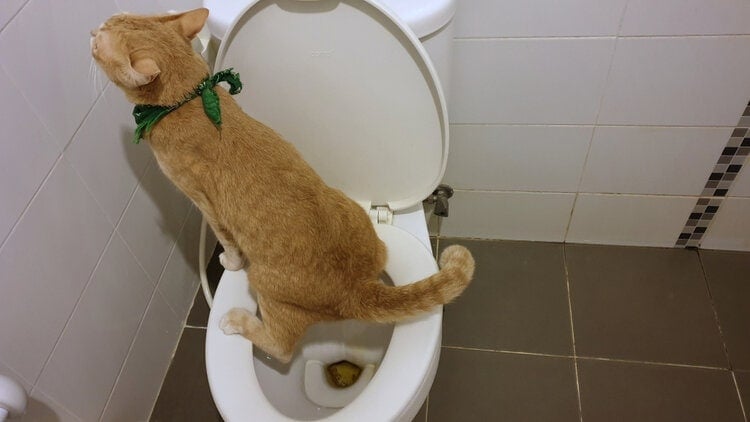Why Flushing Cat Poop Down Your Toilet Can Cause Problems - Tips for Safe Handling
Why Flushing Cat Poop Down Your Toilet Can Cause Problems - Tips for Safe Handling
Blog Article
Right here below you might get a lot of very good insights in relation to How to Dispose of Cat Poop and Litter Without Plastic Bags.

Intro
As pet cat owners, it's essential to be mindful of just how we take care of our feline buddies' waste. While it may seem hassle-free to purge pet cat poop down the bathroom, this practice can have harmful effects for both the setting and human health and wellness.
Environmental Impact
Purging feline poop introduces unsafe virus and bloodsuckers right into the water, posturing a considerable danger to marine ecological communities. These impurities can adversely influence aquatic life and compromise water top quality.
Wellness Risks
In addition to environmental problems, flushing feline waste can likewise posture health dangers to human beings. Feline feces might contain Toxoplasma gondii, a bloodsucker that can create toxoplasmosis-- a potentially severe illness, specifically for pregnant ladies and individuals with weakened immune systems.
Alternatives to Flushing
Fortunately, there are much safer and a lot more accountable ways to get rid of cat poop. Take into consideration the adhering to alternatives:
1. Scoop and Dispose in Trash
The most usual technique of throwing away feline poop is to scoop it into an eco-friendly bag and toss it in the trash. Make sure to use a committed clutter scoop and take care of the waste quickly.
2. Usage Biodegradable Litter
Choose naturally degradable feline trash made from materials such as corn or wheat. These clutters are eco-friendly and can be safely dealt with in the trash.
3. Hide in the Yard
If you have a lawn, take into consideration burying cat waste in a designated area away from veggie yards and water resources. Make certain to dig deep sufficient to avoid contamination of groundwater.
4. Set Up a Pet Waste Disposal System
Invest in a family pet garbage disposal system especially designed for pet cat waste. These systems use enzymes to break down the waste, lowering odor and ecological impact.
Final thought
Responsible family pet ownership extends past providing food and shelter-- it likewise includes appropriate waste monitoring. By refraining from purging pet cat poop down the commode and opting for alternative disposal techniques, we can decrease our ecological footprint and shield human health.
Why Can’t I Flush Cat Poop?
It Spreads a Parasite
Cats are frequently infected with a parasite called toxoplasma gondii. The parasite causes an infection called toxoplasmosis. It is usually harmless to cats. The parasite only uses cat poop as a host for its eggs. Otherwise, the cat’s immune system usually keeps the infection at low enough levels to maintain its own health. But it does not stop the develop of eggs. These eggs are tiny and surprisingly tough. They may survive for a year before they begin to grow. But that’s the problem.
Our wastewater system is not designed to deal with toxoplasmosis eggs. Instead, most eggs will flush from your toilet into sewers and wastewater management plants. After the sewage is treated for many other harmful things in it, it is typically released into local rivers, lakes, or oceans. Here, the toxoplasmosis eggs can find new hosts, including starfish, crabs, otters, and many other wildlife. For many, this is a significant risk to their health. Toxoplasmosis can also end up infecting water sources that are important for agriculture, which means our deer, pigs, and sheep can get infected too.
Is There Risk to Humans?
There can be a risk to human life from flushing cat poop down the toilet. If you do so, the parasites from your cat’s poop can end up in shellfish, game animals, or livestock. If this meat is then served raw or undercooked, the people who eat it can get sick.
In fact, according to the CDC, 40 million people in the United States are infected with toxoplasma gondii. They get it from exposure to infected seafood, or from some kind of cat poop contamination, like drinking from a stream that is contaminated or touching anything that has come into contact with cat poop. That includes just cleaning a cat litter box.
Most people who get infected with these parasites will not develop any symptoms. However, for pregnant women or for those with compromised immune systems, the parasite can cause severe health problems.
How to Handle Cat Poop
The best way to handle cat poop is actually to clean the box more often. The eggs that the parasite sheds will not become active until one to five days after the cat poops. That means that if you clean daily, you’re much less likely to come into direct contact with infectious eggs.
That said, always dispose of cat poop in the garbage and not down the toilet. Wash your hands before and after you clean the litter box, and bring the bag of poop right outside to your garbage bins.
https://trenchlesssolutionsusa.com/why-cant-i-flush-cat-poop/

I'm certainly very enthusiastic about Can You Flush Cat Poop Down The Toilet? and I'm hoping you appreciated the entire blog posting. Sharing is good. Helping people is fun. Many thanks for going through it.
Browse Our Site Report this page